In the Moment:
Michael Frye's Landscape Photography Blog
by Michael Frye | May 10, 2015 | Night Photography
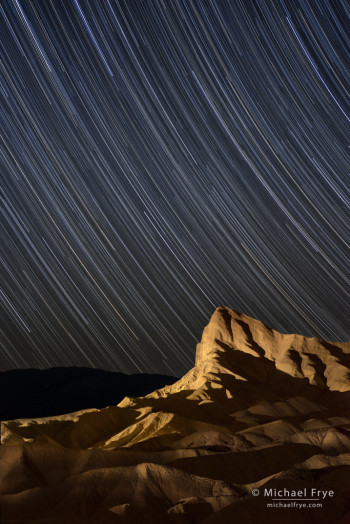
Manly Beacon at night with star trails, Death Valley NP, CA, USA
Manly Beacon is Death Valley’s most iconic feature, seen in millions of photographs from Zabriskie Point, including the image on the cover of the park map and brochure. So naturally I thought it would be fun to light it up at night.
One evening during our recent trip to Death Valley, Claudia and I, accompanied by our friend Robert Eckhardt, started down the Golden Canyon Trail from Zabriskie Point, carrying my powerful (3200 lumens), battery-powered spotlight, and radios for communication. Robert and I wanted a lower vantage point where the Beacon would poke up into the sky, and found a perfect spot. We set up our cameras and made some dusk exposures. Then after dark I hiked about half a mile further down the trail, carrying the spotlight and a radio, to a location I thought would work for the light-painting. Claudia acted as radio operator, and Robert tripped the shutters on both our cameras, while I used the spotlight to illuminate the Beacon.
We took a guess at the exposure, initially leaving the shutters open for 30 seconds at f/4, with the ISO set to 2500. According to Claudia and Robert’s radio reports, this exposure – surprisingly – turned out to be perfect. It did take several tries to get the lighting balance just right, but the problem was that the ridges underneath the Beacon weren’t getting lit from this spot. So I climbed back up the trail to a different location, closer to the cameras, which proved to be perfect for lighting those foreground ridges.
(more…)
by Michael Frye | Sep 3, 2013 | Yosemite Photo Conditions
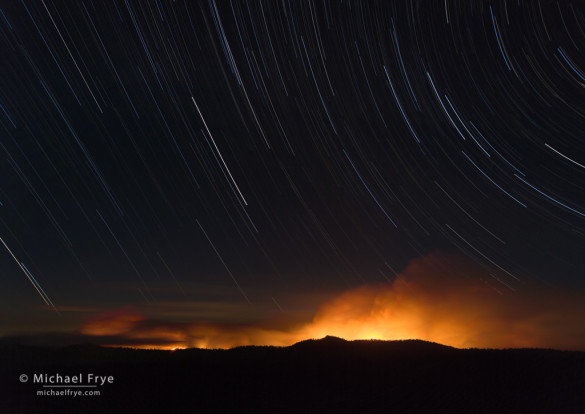
Star trails over the Rim Fire, 8/24/13, Yosemite National Park
On Saturday, August 24th, Claudia and I hiked cross-country to a spot near the Tioga Road with a view of the Rim Fire. I’d picked out this spot, and the route to it, using topographic maps and Google Earth, but you never know until you try it how difficult the route will be, or whether you’ll really be able to find an unobscured view. Fortunately, the hike turned out to be easy, especially compared to our epic bushwhack from two nights earlier. And the view was impressive. The edge of the fire was about six miles away, but the smoke plume was so vast that I couldn’t fit it all in with a 17mm lens.
As the sun went down, I made a series of images of the smoke and fire, some of which are included below. When the sky got dark enough, I set my interval timer to make a series of exposures, each one-minute long, that I could then merge into a star trail sequence. I made about 80 exposures altogether, so the total time for the sequence was about 80 minutes. I then merged the images in Photoshop by setting all but the bottom layer to the Lighten blending mode. You can see the final, merged sequence above. (Here’s link to a post that explains a bit more about this image-stacking technique for star trails.)
(more…)
by Michael Frye | Aug 16, 2013 | Reviews
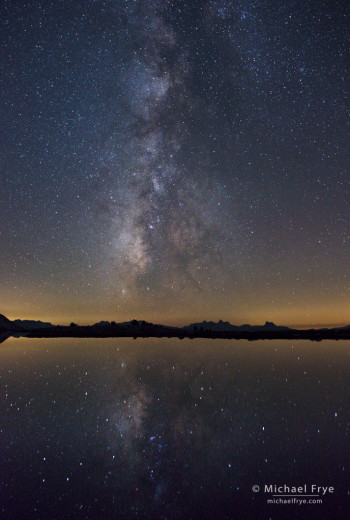
Milky Way reflected in an alpine lake, Yosemite NP, CA, USA. Nikon D800E with 24mm f/1.4 lens; 20 seconds, f/2.8, 6400 ISO
Regular readers of this blog know that I don’t often write about equipment. Equipment is necessary, and important, but not the most important thing in photography.
However, equipment does matter in some situations, like when trying to capture fast-moving subjects, or the faint light of stars, or when you want to make a large print that’s sharp and noise-free.
My regular camera is ancient by the fast-moving standards of the digital age. It’s a 16-megapixel Canon 1Ds Mark II, first introduced in 2004. I haven’t felt a compelling urge to upgrade. Newer models like the Canon 5D Mark II and Mark III have a little higher resolution (21 and 22 megapixels, respectively), but the difference isn’t that significant. They also handle noise better, but again, the advantages are relatively small.
One of the reasons I’ve been slow to upgrade to a new model is because while Canon has been making these modest improvements in image quality, Nikon has been making big leaps. For several years the Nikon sensors (some of which are made by Sony) have outclassed Canon in handling noise – something I could see clearly when looking at student’s photos during workshops. And last year’s introduction of the 36-megapixel Nikon D800 and D800E set a new standard for resolution in a 35mm-style DSLR. All this makes me think about switching, and hesitant to invest in more Canon equipment.
(more…)
by Michael Frye | Dec 7, 2011 | Announcements, Reviews
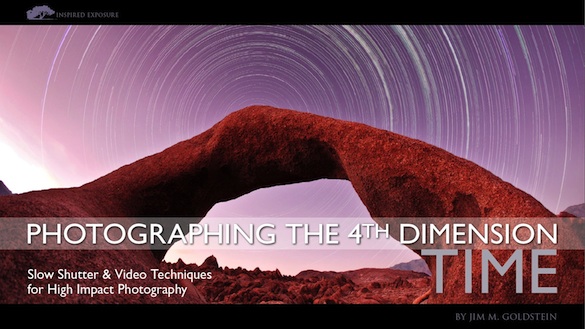
Jim Goldstein has just released a new eBook called Photographing the 4th Dimension – Time. In the book Jim describes seven different slow shutter speed and video techniques for making more creative photographs—including long exposures, light-painting, star trails, time-lapse, and cinemagraphs.
This book is a great way to delve into some new, fun, and creative aspects of photography. If you’ve never tried photographing star trails, making time-lapse videos, or creating cinemagraphs, Jim makes it easy to get started by giving you step-by-step instructions, sometimes including video tutorials.
Just browsing through the book can inspire you to try some new techniques and give your photography a creative kick in the pants. Personally I was intrigued by the cinemagraphs, where part of a still photograph is animated. Some cinemagraphs I’d seen before looked rather cheesy, but after viewing some of the examples here I realize that they can be done subtly, and beautifully, so I’m eager to try them—and it’s nice to have Jim’s detailed instructions for doing so.
(more…)
by Michael Frye | Aug 7, 2011 | Advanced Techniques, Night Photography
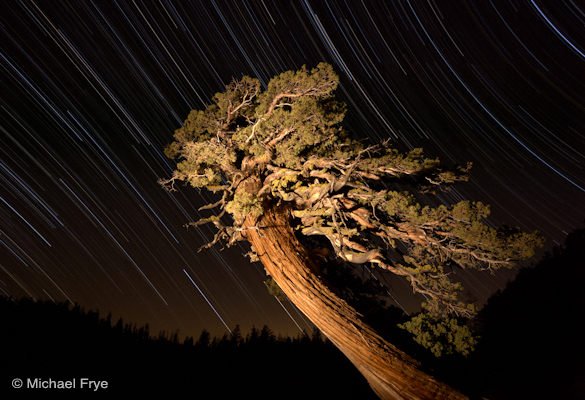
Juniper and star trails near Olmsted Point, Yosemite
Here’s a new image, made last Tuesday evening near Olmsted Point in Yosemite. My friend Mike Osborne calls this the “Bowsprit” tree. What? I didn’t get it either until he explained that a bowsprit is the bent figure with arms splayed back at the bow of old sailing ships. Okay, yeah, this does sort of resemble that.
Anyway, I “painted” this wonderful tree with a flashlight, and used the image-stacking technique to get noise-free star trails. With image stacking the idea is to take a series of short exposures and blend them together, rather than doing one long one. The total exposure time here is about 90 minutes, but one exposure that long would end up being quite noisy. Instead I took 24 four-minute exposures, with only a one-second interval between them. So each of those four-minute exposures has little noise.
(more…)













